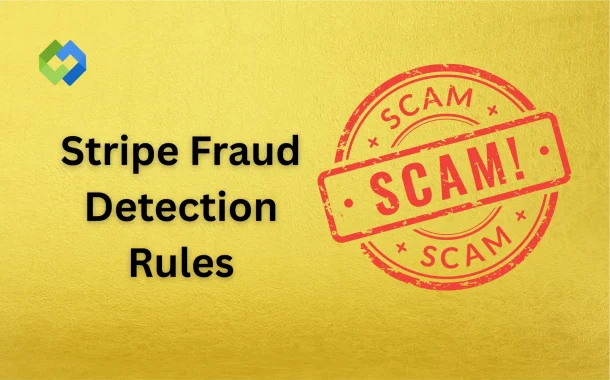Fraud detection is very important for businesses. Online payments can be risky, and fraud can lead to chargebacks and lost revenue. By detecting fraud early, businesses can protect their money and reputation. Effective fraud rules also improve customer experience, as legitimate transactions go through smoothly. Businesses that ignore fraud risks may face serious problems, including fines or legal issues.
Table of Contents
Table of Contents
Types of Fraud Detection Rules in Stripe
Predefined Rules by Stripe
These are built-in rules that automatically flag suspicious activity. They check for common fraud patterns, such as stolen cards, unusual locations, or multiple failed payment attempts. These rules run in the background without extra setup, providing a strong first layer of protection.
Custom Rules Created by Users
Businesses can create rules tailored to their needs. For example, you can block payments from certain countries, flag high-value transactions, or restrict unusual email domains. Custom rules give control over specific risks and allow adjustments based on business type and customer behavior.
Examples of Common Rules
Some typical rules include blocking payments from high-risk countries, flagging multiple attempts with the same card, and reviewing orders over a set amount. Combining predefined and custom rules helps businesses balance security and customer experience.
Setting Up Fraud Detection Rules
Accessing Rules in the Stripe Dashboard
Log in to your Stripe account and navigate to the Radar section. Here, you can view all existing fraud rules and see flagged transactions. The dashboard shows risk levels, rule performance, and insights from past activity, making it easier to understand potential threats.
Creating Custom Rules Step by Step
Click “Add Rule” to set up a new custom rule. You can select conditions such as transaction amount, customer location, email domain, or card usage patterns. Give each rule a clear and descriptive name. You can also combine multiple conditions to make rules more precise and reduce unnecessary blocks.
Testing Rules Before Activation
Before enabling a rule, use Stripe’s testing tools to simulate transactions. This shows which payments would be flagged or blocked. Testing ensures that legitimate transactions go through smoothly while catching suspicious activity, reducing false positives and customer frustration.
Activating and Monitoring Rules
After testing, activate the rule and track its performance over time. Monitor flagged transactions, review any false positives, and tweak conditions if needed. Regular monitoring ensures your rules stay effective as your business grows and fraud patterns change.
Advanced Rule Configurations
Combining Multiple Conditions
You can create rules that use more than one condition to catch complex fraud patterns. For example, you might flag transactions over a certain amount and from high-risk countries. Combining conditions makes rules more precise and reduces the chance of blocking legitimate transactions.
Using Risk Levels and Scoring
Stripe assigns a risk score to each transaction based on various factors. Advanced rules can use these scores to block, review, or allow payments automatically. This helps businesses focus on high-risk transactions without slowing down regular payments.
Handling International Transactions
Cross-border payments can carry higher fraud risk. Advanced rules allow you to flag transactions from certain countries, regions, or IP addresses. You can also review transactions in unfamiliar currencies to prevent unauthorized payments while keeping global customers safe.
Customizing Responses to Flags
Beyond blocking or allowing payments, you can set rules to send alerts, require additional verification, or trigger manual reviews. This gives flexibility in handling suspicious activity while maintaining a smooth experience for genuine customers.
Monitoring and Reviewing Fraud Rules
Tracking Flagged Transactions
After setting up rules, monitor transactions that are flagged by Stripe Radar. This helps you see which payments are being blocked or marked for review. Keeping track of these transactions allows you to identify patterns and detect potential fraud trends early.
Analyzing Rule Performance
Regularly review how each fraud detection rule is performing. Check for false positives, where legitimate transactions are blocked, and false negatives, where suspicious payments slip through. Analyzing performance ensures that your rules are effective and not causing unnecessary friction for real customers.
Updating Rules Over Time
Fraud patterns can change, so it’s important to update your rules regularly. Adjust conditions, add new rules, or remove outdated ones based on transaction data and business needs. Continuous updates help maintain a balance between security and smooth customer experience.
Common Challenges and How to Overcome Them
False Positives and Legitimate Transactions
One common challenge is false positives, where real customer payments are mistakenly flagged as suspicious. This can frustrate customers and lead to lost sales. To overcome this, regularly review flagged transactions and adjust rules to reduce unnecessary blocks. Testing rules before activation also helps prevent false positives.
False Negatives and Missed Fraud
Sometimes, fraud slips through your rules, called false negatives. This can result in chargebacks and financial losses. To minimize this, combine predefined and custom rules, use risk scoring, and monitor patterns in transactions. Updating rules based on new fraud trends is also important.
Adapting to Business Growth
As your business grows, transaction volume and types change. Rules that worked before may become outdated. Regularly review and refine rules, especially for high-risk regions or large payments, to ensure ongoing protection.
Balancing Security and User Experience
Overly strict rules can block genuine customers, while lenient rules may allow fraud. Find a balance by testing rules, monitoring performance, and using Stripe’s insights to optimize detection without hurting customer experience.
Handling Complex Transactions
Some transactions, like subscriptions, high-volume orders, or international payments, can be harder to assess. Complex transactions may trigger false alerts or bypass basic rules. Overcome this by creating specialized rules for these cases and using Stripe’s advanced scoring and verification tools.
Conclusion
Stripe fraud detection rules help businesses protect payments and sensitive data. Using both predefined and custom rules allows you to catch suspicious activity early. Monitoring transactions and testing rules reduces mistakes and keeps real customers safe. Advanced settings, like risk scoring and combined conditions, make your fraud detection smarter and more precise.
Regularly reviewing and updating rules is important because fraud patterns change over time. Balancing security with user experience ensures smooth payments while preventing losses. Following best practices in Stripe’s fraud detection keeps your business safe, builds trust, and maintains a reliable payment system.














